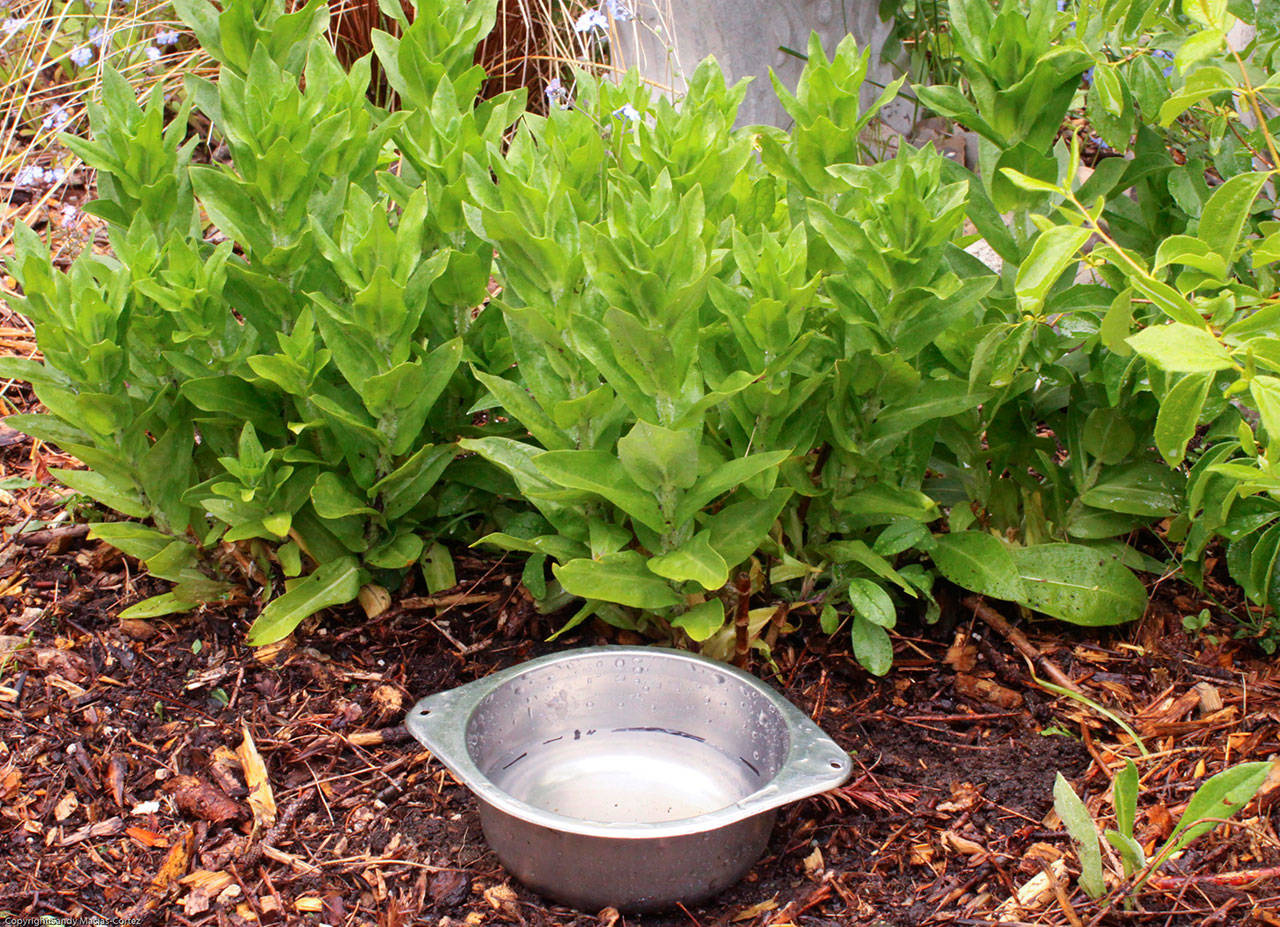Perhaps you have been given watering instructions like this before: “During the growing season make sure your plant receives an inch of water each week” What does this measurement mean? What is it based on? How do you know that you have provided the necessary water?
“Recommended inches of water” refers to the amount of water (from rainfall and through irrigation) that must be applied to the surface of the soil to 1) penetrate the soil to the level of a plant’s roots and 2) meet the plant’s water requirements. Penetration of water to the depth of the roots is desirable because the roots absorb water for use by the plant. Watering to the expected depth of a plant’s roots also encourages deeper and stronger root growth, both of which make the plant more drought tolerant.
• Root depth depends largely on the type of plant and age.
• Roots of small plants such as ground-covers and annuals are usually contained within 1 foot of the soil surface.
• Roots of medium-sized plants such as shrubs are usually within 2 feet of the soil surface.
• Roots of large plants such as trees are usually within 3 feet of the soil surface.
There are exceptions. Some annuals (such as tomatoes and pumpkins) have very deep roots, reaching 3 or more feet into the soil. Some trees (such as maples) and shrubs (such as blueberries) have relatively superficial roots that are concentrated in the top 12-18 inches of soil.
How much water is necessary to reach the root zone? One inch of water applied evenly to the soil surface without run-off will reach, on average, a soil depth of 6-8 inches. Therefore, the average small plant will need about 1inch of water per week; the average medium-sized plant will need 1-2 inches per week; and the average large plant will need 2-3 inches per week.
Once you know how many inches of water a plant needs, how do you know it has received that much in a week? When measuring rainfall (or water from an overhead sprinkler that is distributed slowly and evenly across a planting area), you can use a rain gauge or small straight-sided container (such as a tuna can or cat food can) placed on the soil surface. The depth of water in the gauge or container indicates how much water has been applied to the soil surface.
What do you do if you are applying water with a watering can or drip system? A little math will help. A gallon of water is 231 cubic inches. To apply an inch of water to a square foot of soil (1 inch by 12 inches by 12 inches) you will need 144 cubic inches of water or approximately two-thirds of a gallon of water.
Using this conversion, you will see that to apply 1 inch of water to one-square yard (1 inch by 36 inches by 36 inches or 1,296 cubic inches) – the surface area covered by a small bush – you will need to apply about 5 gallons of water. To apply 1 inch of water to a 5 foot by 5-foot area (1 inch by 60 inches by 60 inches or 3,600 cubic inches) – the surface area covered by a dwarf fruit tree – you will need to apply about 15 gallons of water.
If you are using a drip system with emitters that supply a certain amount of water per unit time (e.g., ½ gallon per hour, 1 gallon per hour), you can estimate the amount of water applied to a plant (in gallons) by multiplying the combined flow per hour of the emitters around a plant by the run time.
With any watering method, you can check to see if sufficient water has been applied by digging to the depth of the expected root zone with a trowel or spade. If the soil is moist at that level, you have done your job. If not, more water is needed.
Other factors affecting watering practices
In addition to the depth of the roots, other factors affect the desired amount of irrigation applied each week:
Type of soil
Sandy soil holds less water than clay soil and will dry out more quickly; more irrigation will be needed.
Weather
In rainy conditions, the amount of water applied through irrigation should be reduced by the amount of rainfall received. If it is hot and dry or windy, plants (and the surrounding soil) lose water more quickly; more irrigation will be needed.
Location
Soil on slopes often drains (and dries out) faster than soil on level ground and likely requires more irrigation. Similarly, soil in raised beds and containers drains more rapidly requiring more frequent irrigation than in-ground plantings.
Mulch
A thick layer of mulch minimizes evaporation of water and improves moisture retention in the soil. Plantings with a 2- to 3-inch layer of mulch require less frequent irrigation than those without mulch.
Remember, the goal is to get the water down to the plant’s root zone. Do not water lightly each day to reach to the total amount of water for the week; light watering results in a wet soil surface and dry root zone area. Rather apply the recommended water slowly over one to three applications so that the water penetrates deeply into the soil and run-off is minimized.
For more watering advice, see Washington State University’s “Watering Home Gardens and Landscape Plants” (EB1090) available for free at pubs.cahnrs.wsu.edu/publications/pubs/eb1090.
Jeanette Stehr-Green is a WSU-certified Clallam County Master Gardener.


